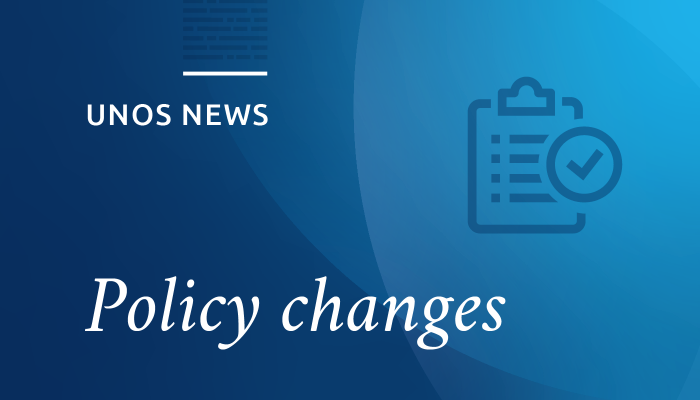Audience:
- Primary: Transplant center staff from liver, kidney, KPD and living donor programs who use Waitlist and DonorNet; transplant administrators, transplant program directors, transplant quality staff, OPO procurement coordinators and managers, OPO executive directors, OPO quality staff
- Secondary: Lab staff who list transplant candidates for transplant centers
Implementation date: August 10, 2017:
Allocation policies are now in effect. In order for your adult liver-kidney candidate to qualify for liver-kidney allocation or your kidney candidates to qualify for a new priority classification on the kidney waiting list (“the safety net”), you must complete the new fields.
At-a-glance:
In June 2016, the OPTN/UNOS Board approved a change to the way liver-kidney combinations are allocated. This change created medical eligibility criteria for adult candidates seeking both a liver and a kidney, which means you now have to document and report new information. Pediatric liver-kidney candidates (those registered on the liver waiting list prior to their 18th birthday) do not have to meet the new medical eligibility criteria but must be registered on both the liver and kidney waiting lists to be eligible. The new policy also provides a safety net for those individuals who are registered on the kidney waiting list within 60-365 days after their liver transplant. It gives these individuals some additional priority for local kidney allocation if they meet specific medical requirements. Read policy notice for more detail.
You have seen new fields in Waitlist for liver candidates and kidney candidates that reflect this policy change for the last few months.
If you have entered data in the new fields, the system will be able to determine whether your candidate is eligible. In the Reports section of Waitlist, two new reports will help you identify possible candidates and manage eligible candidates once you have entered the qualifying data:
- A new liver report lists liver candidates who may be or are eligible for SLK.
- A new kidney report lists kidney candidates who may be or are eligible for prioritization on kidney matches because of a prior liver transplant.
Changes to Waitlist screen for Kidney Candidates:
If your candidate was registered on the kidney waiting list before the one-year anniversary of their most recent liver transplant, you will see a new section titled Priority for Liver Transplant Recipient on Kidney Match. Within this section, you can begin entering the following data 60 or more days after your kidney candidate received their liver transplant:
- Date of test or treatment
- Whether they are on dialysis
- CrCl (mL/min)
- eGFR (mL/min)
Once you enter the data, you will be able to see if your candidate is eligible for priority status and for how long.
In the reports section of Waitlist, a report titled, Kidney Priority for Liver Transplant Recipient helps you identify which kidney candidates are eligible or may be eligible for priority for kidney transplant. This priority is also referred to as a safety net. From the names on the report, you can link directly to the data entry section.
Changes to Waitlist screen for Liver Candidates:
If your adult liver candidate is registered for a kidney or you have checked the Kidney box within the Additional Organs section, you will see a new section titled Liver-Kidney (SLK) registrations. Within this section, you can enter the following data to determine if your adult liver candidate is medically eligible for SLK:
Diagnosis:
Chronic kidney disease (CKD) : must enter data for at least one of following :
- Has begun dialysis?
- CrCl (mL/min) and date
- eGFR (mL/min) and date
Sustained acute kidney injury: must enter data for at least one of following:
- Dialysis received and date
- CrCl (mL/min) and date
- eGFR (mL/min) and date
Metabolic disease: must check at least one of the following:
- Hyperoxaluria
- Atypical hemolytic uremic syndrome (HUS) from mutations in factor H or factor I
- Familial non-neuropathic systemic amyloidosis
- Methylmalonic aciduria
Transplant nephrologist name who confirmed diagnosis
Important reminder: if SLK eligibility is based upon a diagnosis of sustained acute kidney injury, you must confirm the data at least once every 7 days for the candidate to remain eligible.
Once you save the data, you will be able to see if your candidate is eligible for SLK. If your candidate is ineligible for SLK, you will see the reason why.
In the Reports section of Waitlist, a Liver-Kidney (SLK) Candidate Report helps you identify which liver candidates are eligible or may be eligible for SLK. From the names on the report, you can click on the Waitlist ID link to go directly to the candidate’s record.
An indicator on the liver match results will let the OPO know if the kidney is either required, permissible or not eligible to be offered with the liver for a potential recipient. The kidney match will include a new match classification that gives eligible recipients of previous liver transplants who meet medical criteria some additional local priority for a kidney.
Questions and Resources:
Policy and system training is available on UNOS Connect to help you with these changes.
If you have questions about the new fields in Waitlist, contact the UNet Help Desk at 800-978-4334. Contact your UNOS administrator at 804-782-4800 if you have questions related to SLK policy.

